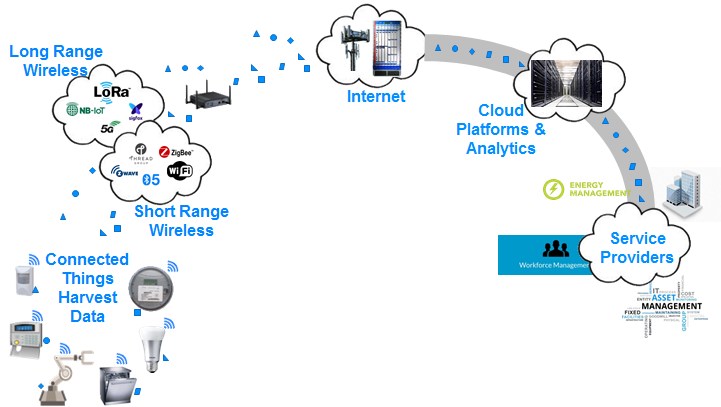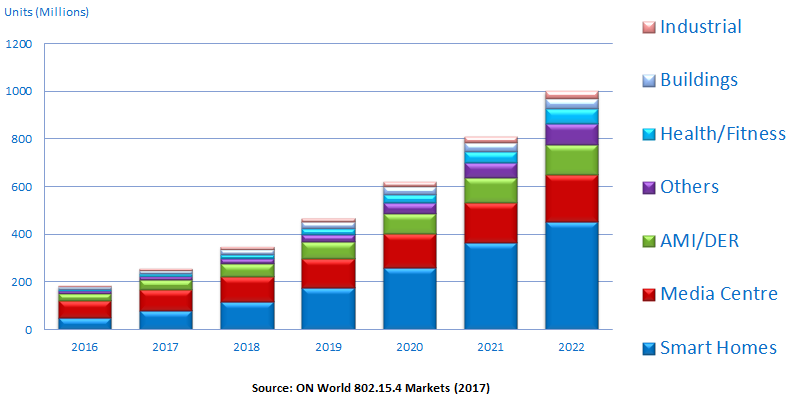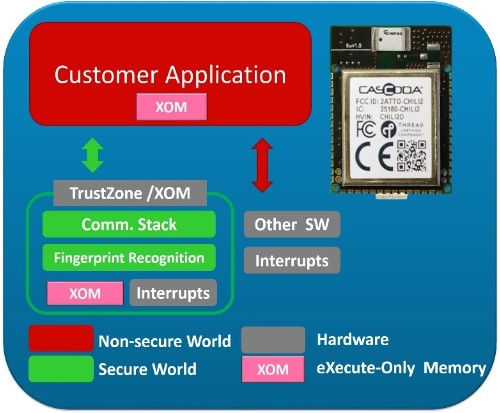5G new infrastructure series: Microcontroller and short-range wireless communication
Introduction to the communication standards of the IoT world
The communication technology of IoT can be divided into two main categories: short-range and long-range based on the signal transmission range, in which main short-range transmission technologies include Wi-Fi, ZigBee, Z-Wave, Thread, Bluetooth™, and Wi-SUN, etc. It is mainly applied to current mobile devices such as mobile phones, tablets and wearable devices, or in fields such as smart homes, smart factories, and smart lighting, etc. Long-range communications mainly include mobile communications such as 2G, 3G, and 4G, etc. in the past; however, IoT applications were different from the transmission requirements of mobile communications, which included large bandwidth and low latency. Many IoT applications have little demand for data packets and have a greater tolerance for delays. They also need to cover wider ranges or go deeper underground or penetrate areas that are severely covered etc. For the applications described above, long-range low-power communication technologies were developed and are collectively referred to as Low Power Wide Area Network (LPWAN); in which the licensed spectrum communication technology is mainly NB-IoT. The figure below is a simple IoT system architecture diagram.

Short-range wireless communication technology: The last mile of the IoT world
If selections were made based on the features of long-range and short-range wireless communication technologies, short-range communication with a general microcontroller plays an important role in data collection on terminal devices, especially those with sensors.
- Low-Power Wide-Area Network Range > 1km, such as LoRA, SigFox, NB-IoT
- Short Range < 100m, such as ZigBee, Thread, Z-Wave or Bluetooth
Among the many short-range communication technology fields, the IEEE 802.15.x family is the representative and has many different branches; the important representative technologies were organized as follows:
|
Short-range communication technologies |
||||||
|
|
Wi-Fi |
ZigBee |
Z-Wave |
Thread |
Bluetooth® |
Wi-SUN |
|
Standard |
IEEE 802.11 |
IEEE 802.15.4 |
IEEE 802.15.4 |
IEEE 802.15.4 |
Bluetooth SIG, IEEE 802.15.1 |
IEEE 802.15.4 |
|
Spectrum |
2.4GHz/ 5GHz/ 60GHz |
868MHz/ 915MHz/ 2.4GHz |
868MHz/ 908MHz |
868MHz/ 915MHz/ 2.4GHz |
2.4GHz |
868MHz/ 915MHz/ 2.4GHz |
|
Maximum transmission distance |
250m (802.11n) |
10~100m |
40~200m |
10m~100m |
10~100m |
1000m |
|
Maximum transmission rate |
6,757Mb/s (802.11ad) |
250Kb/s |
40Kb/s |
250KB/s |
1Mb/s |
50Kb/s~ 300Kb/s |
Data source: Various alliance websites, organized by Nuvoton
To sum up the previously organized data, we think that providing a set of short-range reference design modules that is easy to develop and equipped with communication security consideration features is very helpful to the industry. Among the many standards that comply with the IEEE 802.15.4 standard, such as ZigBee Pro, Thread and RF4CE, we discovered that the development of Thread has the most potentials; reasons include the following: (1) It is supported by major companies such as Google, Arm, and Samsung, etc., Apple also joined the Thread faction in 2018. (2) IP-based protocols can be easily integrated into software communication protocols. (3) High standardization, high interoperability, high security and is suitable for devices that use batteries for power supply. The figure below is a forecast statistics stable of the market development.

From the figure above, we can see that the application of related protocols based on IEEE 802.15.4 is still expected to grow and mainly focuses on ZigBee and Thread, especially Thread. In terms of application, according to the data from market surveys, the main application fields include Smart Home, Medical Devices, Auto Metering, Smart Building, and Industrial fields.

Thread reference design for NuMicro M2351
Nuvoton collaborated with Cascoda in Great Britain and launched a Transceiver reference design that uses a microcontroller with 802.15.4 that included a MAC (Media Access Control) layer. Since M2351 can provide TrustZone® and XOM functions, the communication protocol layer can be placed inside the secure area or XOM (eXecute-Only Memory) based on the program development plan; and since the Transceiver ICs (CA8210 and CA8211) from Cascoda all include pre-processing of the MAC layer (ROM-based MAC firmware and MAC Co-processor), the M2351 will be more than enough for the processing of the MAC layer post-processing and its top IP layer and above, including the application layer. Therefore the solution that includes MAC pre-processing (Low-MAC Transceiver) has the following benefits:
- The timing impact to the API of the communication protocol is smaller and the response time is faster; this complies with the standard more
- It has a smaller dependency on specific microcontrollers and OS
- Pure software processing of the MAC layer is less risky; the protocol cannot be tampered with as easily and is safer
We organized the software application architecture diagram of the M2351 terminal as follows:

Based on the architecture diagram above, it is possible to achieve a wireless transmission power increase of approximately 3 times based on Cascoda’s innovative patents in wireless transceivers; it can double the transmission distance compared to other average solutions while having ultra-low power-consumption performances. In other words, it can provide longer battery usage time for devices that use batteries for power supply. Furthermore, no additional microcontroller that focuses on the processing of wireless communication protocol is needed; the entire reference design module includes two main chips that can fully handle the requirements for the communication and end-product designs; for example IoT applications such as wireless meter reading, remote surveillance, smart home, smart factory, and smart building, etc.
Detailed features and market opportunities brought by Nuvoton’s 802.15.4 Thread reference design
Since Nuvoton’s M2351 microcontroller has sufficient resources, not only can the TrustZone® area be used to place the OpenThread communication protocol, there is remaining memory space to run upper-layer applications and even RTOS. These upper-layer applications or RTOS can be placed at non-secure areas outside of TrustZone® to fully utilize the features of Armv8-M and guarantee software security for network communication with external networks. Such a solution can bring the following business opportunities:
- The doubled receiving distance solved the stability issue of the service range.
- The standard-compliant reference design platform is fully compatible with existing 802.15.4 Thread standards; Cascoda and Nuvoton even provide free OpenThread Stack reference designs to make it easier for communication software protocol developers to integrate.
- Wide coverage of communication/surveillance areas while using low-power.
- Quickly keep up with mainstream applications on the market. 802.15.4 already exists on Comcast, Amazon Echo+, and Google NEST; Cascoda and Nuvoton provide an open universal platform that is very convenient for the development and design of various products requiring short-range communications. It is an innovative, secure and high performance 802.15.4 Thread terminal product reference design example.